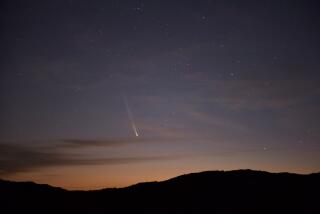Halley’s Is Here, Viewers Learn, but It’s No Streaker
- Share via
The young woman, taking her first look at Halley’s comet through a small telescope at an observatory near Frazier Park, did not even try to conceal her disappointment Saturday night.
“Is that it?” she asked, incredulously. “I want my money back.”
“Were you expecting it to streak across the sky?” asked a voice out of the dark, one of about a dozen amateur astronomers who had gathered at the site.
Sir Edmund Halley’s comet showed up right on schedule for Southland viewers over the weekend and looked exactly as astronomers said it would--like a faint, fuzzy little puff in a distant sky.
The weather cooperated throughout most of Southern California, providing reasonably clear skies, although in many areas it was so cold that the clatter of teeth could be heard above the muted hum of motor-driven telescopes.
The comet, still so dim that it is hard to find even with a good set of binoculars, could be found just to the right of the Pleiades star cluster, also known as the Seven Sisters. Although the view was far from spectacular, it drew many city dwellers into the mountains and deserts north and east of Los Angeles, where the city lights did not interfere.
Because of its celebrity status, Halley’s comet has prompted thousands of lay persons to take a closer look at the skies. Serious amateurs, of course, regard these late arrivals as astronomy’s fair-weather friends, backyard star-gazers who will show up for the celebrated event and then disappear for another 75 years.
A Regular Thing
“We come up here every weekend,” said Tom Greska, an engineer with Mattel who has built a 17.5-inch telescope at the Lockwood Observatory, a facility maintained by an amateur astronomy club in the Lockwood Valley near Frazier Park.
“There are at least half a dozen comets overhead right now, and most of them are brighter than Halley’s,” snorted one amateur as he braced himself against the cold Saturday night and huddled over his 10-inch telescope. “People only come out for this because the comet is so famous.”
Although the comet will continue to brighten in the weeks ahead, it will never offer the kind of spectacle during this visit that is associated with the history of Halley’s comet, the most famous of the celestial wanderers. The view from the Southern Hemisphere will be considerably better, but even there it will not match most past performances, astronomers say, because the comet is not coming as close to the Earth this time.
In its last appearance in 1910, the comet put on a splendid show. For a while, the tail of the comet stretched from horizon to horizon. It is little wonder that more primitive people who watched this strange phenomenon grow brighter and closer with each passing night were at times terrified by the sight. The comet was blamed for all sorts of ill fortune, from plagues to the fall of monarchies.
Clearing the Mystery
It is safe to say that those days are gone now, and nearly every night some astronomer somewhere in the world is peeling back another layer of mystery that surrounds the comet.
In March, five spacecraft--one European, two Soviet and two Japanese--will pass by the comet, sending more information back to Earth than scientists have been able to collect in the 22 centuries since the comet’s first recorded visit. During that period every major telescope on Earth will focus from time to time on the comet, collecting more data about what is believed to be a dirty snowball hurling through space.
One reason scientists are so fascinated with comets is that they offer a chance to study matter in the solar system in a primitive state. Comets could offer clues about the primordial mixture of gasses and matter from which the solar system was formed about 4.5 billion years ago.
More to Read
Sign up for Essential California
The most important California stories and recommendations in your inbox every morning.
You may occasionally receive promotional content from the Los Angeles Times.












